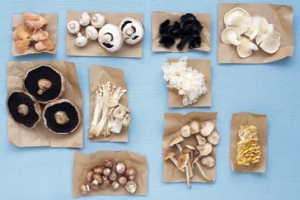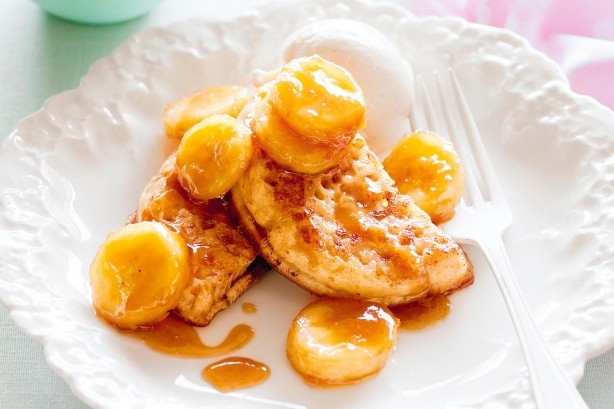Mushrooms
Delicious, low in fat and packed with nutrients, mushrooms come in many varieties and are a highly versatile ingredient.

Andrew Lehmann
Sensitive to light and temperature, mushrooms grow on decaying matter or in harmony with living plants and trees. The first cultivated mushrooms were the champignons of Paris, which were grown in caves filled with horse manure around the city. Mushrooms have long been prized in history by high society as a delicacy. Today there are still a few varieties in Europe and Asia, such as the morel and matsutake, which remain an indulgence on any menu par excellence. Even so, most introduced varieties cultivated in Australia are affordable, accessible and fast becoming more than just 'meat for vegetarians'.
Varieties
From the common button mushroom to the more exotic-looking white cloud ear and yellow oyster, mushrooms add great nutritional value and taste to meals.
Pink oyster
Pink oyster, also known as the flamingo oyster, has the same taste and texture as the oyster mushroom.
Button
The button or white mushroom is the most commonly available mushroom. It is picked before the cap opens to expose its grey gills.
Cup
Cup mushrooms are the product of a mature button mushroom. Similar to the button, their caps remain closed and their flavour is slightly stronger.
Enoki
The delicate enoki is grown as a cluster of small white-capped, long-stemmed mushrooms. Also called enokitake, they can be eaten raw or lightly cooked in soups and stir-fries.
Shimeji
Also known as beech mushrooms, the shimeji is a Japanese variety grown in clumps with short, thick stems. Colour ranges from whitish grey to pale brown.
Portobello
The large portobello mushroom is ideal for grilling or baking due to their size and meaty flavour.
Swiss brown
Similar to the button mushroom, yet with a firmer texture, the Swiss brown has a light brown cap, which is sometimes slightly mottled.
Black wood ear
The black wood ear mushroom has a delicate flavour and is prized more for its slippery, yet crunchy texture when cooked.
White cloud ear
Named after its cloud-like appearance, it is also called white jelly fungus, which denotes its jelly-like texture.
Oyster
Oyster mushrooms are named for their white shell-like appearance. They have soft delicate flesh and are available in pink and yellow varieties.
Shiitake
Native to Asia, shiitake mushrooms have dark umbrella-shaped caps and a spongy texture. They are used extensively in Chinese and Japanese cuisine.
Yellow oyster
Yellow oyster mushrooms, like the pink variety, have a shorter shelf-life than other mushrooms and lose their colour and taste through cooking, so are best eaten raw.
Chestnut
So called because of their nutty flavour, they are firm in texture and hold their shape when cooked.
Buying and storing
Some varieties of mushroom are sold pre-packaged, so it can be difficult to determine freshness when buying. Look for any signs of mould, sliminess or shrivelling due to dehydration. When buying closed cap mushrooms, such as button or cup, check to see the cap is still closed and firm, as it will open with age. All fresh mushrooms should have good shape and bright, unblemished colour. Older mushrooms tend to shrivel and have a greyer tinge. All mushrooms bought packaged can be left in their packaging for up to three days in the crisper section of the refrigerator. Loose mushrooms should be stored similarly in paper bags.
Preparation and cooking
- Most packaged mushrooms do not require cleaning before cooking, although it is advisable to check for any signs of dirt or grit.
- Use a damp cloth to clean mushrooms. Due to their porous flesh, mushrooms should never be washed, as they absorb liquid and become saturated.
- Before cooking, trim the base of the stems where the individual mushroom or cluster joins, as this area is often chewy in texture, then choose the right cooking technique for the variety of mushroom. As a rule of thumb, the more delicate the mushroom, the less cooking time is required. Most mushrooms however, will not hold up well to lengthy cooking.
Tips & facts
Mushroom gathering has been popular for centuries, from the Romans to the French today. Collecting mushrooms can be rewarding, yet quite dangerous if you don't know what you're doing. Never pick mushrooms to eat in the wild unless you can identify them properly.
Of the 120,000 species of mushrooms recorded in history only 1,841 have been recognised as being edible. Many mushrooms contain toxins that are highly poisonous and deadly, so it's best to leave the picking to the experts.
Mushrooms, such as morels or shiitakes, are not always easy to find fresh, yet are available dried all year round from delicatessens and Asian grocers. The flavour of dried mushrooms is more concentrated, making them a better alternative to the fresh.
Related article
Button mushrooms
Flat mushrooms
Oyster mushrooms
Source
Notebook: — May 2007 , Page 115
Author
Lisa Featherby














































